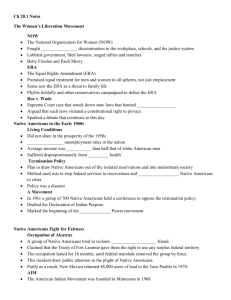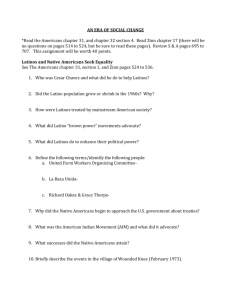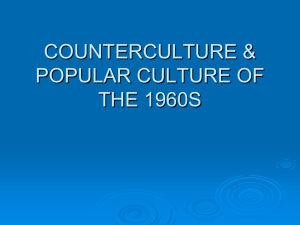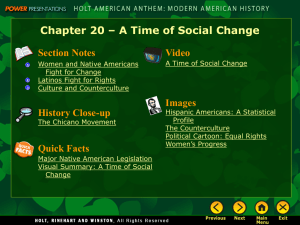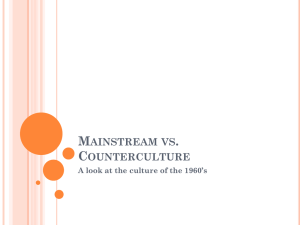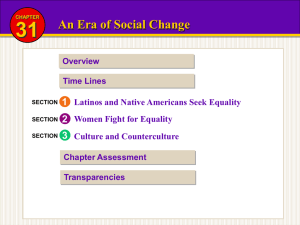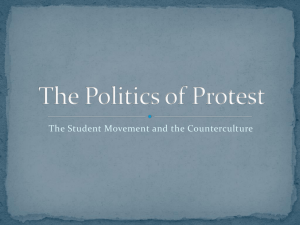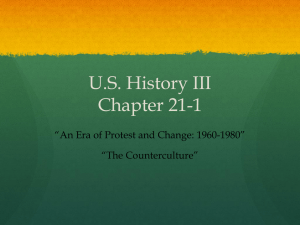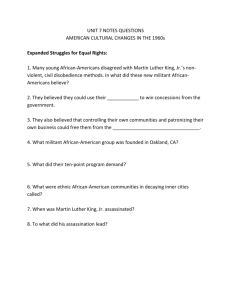US History CH 30 Notes Women and Native Americans Fight for
advertisement
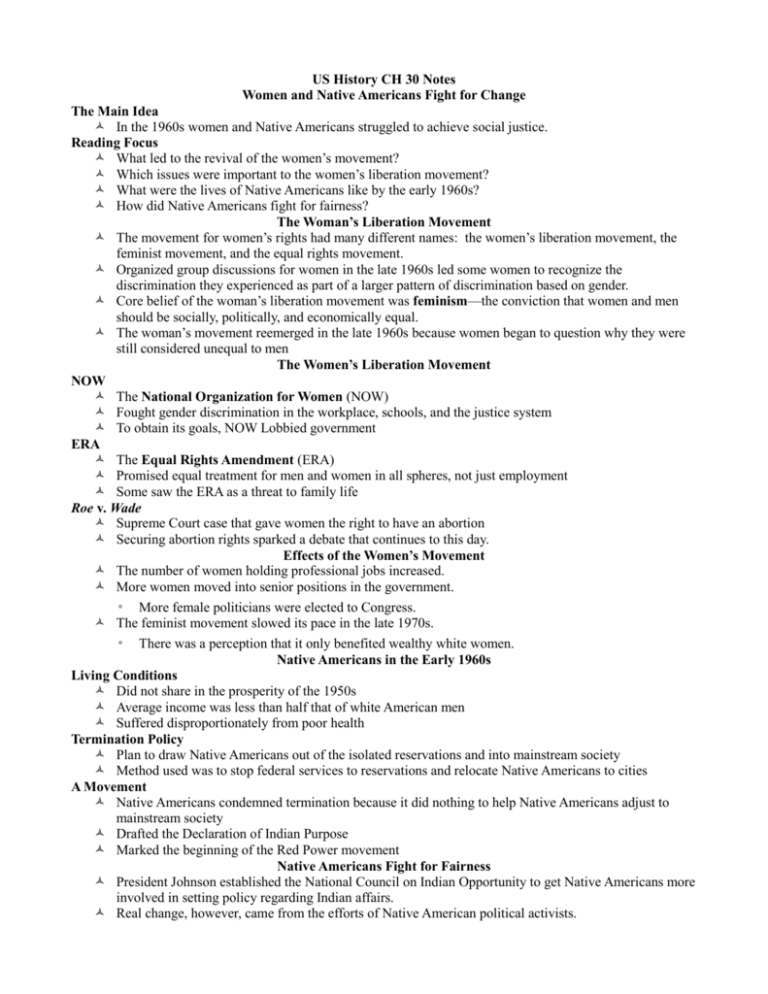
US History CH 30 Notes Women and Native Americans Fight for Change The Main Idea In the 1960s women and Native Americans struggled to achieve social justice. Reading Focus What led to the revival of the women’s movement? Which issues were important to the women’s liberation movement? What were the lives of Native Americans like by the early 1960s? How did Native Americans fight for fairness? The Woman’s Liberation Movement The movement for women’s rights had many different names: the women’s liberation movement, the feminist movement, and the equal rights movement. Organized group discussions for women in the late 1960s led some women to recognize the discrimination they experienced as part of a larger pattern of discrimination based on gender. Core belief of the woman’s liberation movement was feminism—the conviction that women and men should be socially, politically, and economically equal. The woman’s movement reemerged in the late 1960s because women began to question why they were still considered unequal to men The Women’s Liberation Movement NOW The National Organization for Women (NOW) Fought gender discrimination in the workplace, schools, and the justice system To obtain its goals, NOW Lobbied government ERA The Equal Rights Amendment (ERA) Promised equal treatment for men and women in all spheres, not just employment Some saw the ERA as a threat to family life Roe v. Wade Supreme Court case that gave women the right to have an abortion Securing abortion rights sparked a debate that continues to this day. Effects of the Women’s Movement The number of women holding professional jobs increased. More women moved into senior positions in the government. ◦ More female politicians were elected to Congress. The feminist movement slowed its pace in the late 1970s. ◦ There was a perception that it only benefited wealthy white women. Native Americans in the Early 1960s Living Conditions Did not share in the prosperity of the 1950s Average income was less than half that of white American men Suffered disproportionately from poor health Termination Policy Plan to draw Native Americans out of the isolated reservations and into mainstream society Method used was to stop federal services to reservations and relocate Native Americans to cities A Movement Native Americans condemned termination because it did nothing to help Native Americans adjust to mainstream society Drafted the Declaration of Indian Purpose Marked the beginning of the Red Power movement Native Americans Fight for Fairness President Johnson established the National Council on Indian Opportunity to get Native Americans more involved in setting policy regarding Indian affairs. Real change, however, came from the efforts of Native American political activists. Congress passed laws that enhanced education, health care, voting rights, and religious freedom for Native Americans. Native Americans Fight for Fairness Occupation of Alcatraz A group of Native Americans tried to reclaim Alcatraz Island. Claimed that the Treaty of Fort Laramie gave them the right to use any surplus federal territory The occupation lasted for 18 months, until federal marshals removed the group by force. Partly as a result, New Mexico returned 48,000 acres of land to the Taos Pueblo in 1970. The successful occupation of Alcatraz led to the founding of the American Indian Movement AIM The American Indian Movement was founded in Minnesota in 1968 Became the major force behind the Red Power movement Goals of Aim were a renewal of traditional cultures, economic independence, and better education for Native Americans During “The Trail of Broken Treaties” protestors took over the Bureau of Indian Affairs Accessing the Progress of the Fight for Fairness Congress passed a number of laws in the 1970s to enhance education, health care, voting rights, and religious freedom for Native Americans. The Red Power movement succeeded in instilling a sense of pride in Native Americans around the nation Despite these accomplishments, Native Americans continued to face many problems. Unemployment remained high and the high school dropout rate among Native Americans was the highest in the nation. Latinos Fight for Rights The Main Idea In the 1960s Latinos struggled to achieve social justice. Reading Focus What were the lives of Latinos like in the early 1960s? What event launched Latinos’ struggle for social justice? What were the main goals of the movements for Latino rights? Latinos in the Early 1960s More than 900,000 Latinos lived in the United States in 1960. A Latino is any person of Latin American descent. One-third of Mexican American families lived below the poverty line and twice as many Mexican Americans as white Americans were unemployed. Latinos faced discrimination in education. ◦ Schools had less qualified teachers, fewer resources, and shabbier facilities. In politics Latinos had far less power than the size of their population warranted. Latinos’ Struggle for Social Justice Social Justice Latinos sought social justice—the fair distribution of advantages and disadvantages in society. César Chávez He co-founded the National Farm Workers Association—a union of Mexican American farmworkers. His leadership inspired many Mexican Americans to fight discrimination in their lives. The Delano Grape Strike In 1965 migrant farm workers went on strike in California and asked people to boycott grapes. The workers wanted to put pressure on growers to meet their demands for better pay an better working conditions Dolores Huerta and César Chávez agreed to help. Some 5,000 grape workers walked off their jobs. The Delano Grape Strike lasted for five years. ◦ Union activists and sympathetic volunteers stood in front of grocery stores nationwide, urging Americans not to buy grapes. The growers finally gave in and finally settled with the union. The success of the strike made César Chávez a national figure. The Movement for Latino Rights Chicano Movement A shortened form of mexicanos Wanted to convey ethnic pride and commitment to political activism Reies López Tijerina was an early Chicano leader who formed the Alianza Federal de Mercedes (Federal Alliance of Land Grants). Rodolfo “Corky” Gonzales, another leading figure in the Chicano movement, founded the Crusade for Justice. A group of college students in Texas formed the Mexican American Youth Organization (MAYO). José Angel Gutiérrez founded La Raza Unida Party (RUP). Working-class Chicano students in Los Angeles formed the Brown Berets, one of the most militant organizations in the Chicano movement. Movement for Latino Rights La Raza Unida Gutiérrez formed RUP (“the united people”) political party Campaigned for bilingual education, improved public services, education for children of migrant workers, and an end to job discrimination Disagreements among RUP leaders caused the party to fall apart in the late 1970s. Brown Berets One of the most militant organizations in the Chicano movement Began by protesting against police brutality in East Los Angeles Supported efforts of Chicanos to regain their historic lands, the National Farm Workers’ campaigns, and protested high number of Chicano deaths in Vietnam Disbanded in 1972 Movement for Latino Rights Boricua Movement Name by which many Puerto Ricans refer to themselves Many Puerto Ricans migrated to the mainland United States in order to escape slow economic growth and lack of opportunity in Puerto Rico Immigrants experienced social and economic discrimination. Boricua Movement’s goals were self-government for Puerto Rico and better conditions for all Puerto Ricans. Cuban Americans Many Cubans who came to the United States in the 1960s and 1970s were seeking escape from Fidel Castro's Communist Government The majority of immigrants were professionals and business people. Most Cuban Americans who organized for change were seeking changes for Cuba—the overthrow of Castro and communism. Culture and Counterculture The Main Idea The counterculture that emerged in the 1960s and 1970s left a lasting impact on American life. Reading Focus What led to the rise of the counterculture? What was life like in the counterculture? How did mainstream American society react to the counterculture? What legacy did the counterculture leave behind? The Rise of the Counterculture The counterculture of the 1960s was a rebellion of teens and young adults against mainstream American society. Young Americans believed that society’s values were hollow and its priorities were misplaced. They called the mainstream the Establishment. They wanted to create an alternative culture based on peace and love. Where did the counterculture come from? The number of teens and young adults in the United States rose dramatically in the 1960s. These young people were living in turbulent times: threat of nuclear war, racial discrimination and segregation, the Vietnam War, and environmental pollution. Rising Student Activism Students on college campuses began rebelling against school policies they considered restrictive, unjust, or not relevant. At the University of California at Berkeley students protested when school officials banned speech making and political organizing at the entrances to the campus. The events at Berkeley marked the beginning of the Free Speech Movement, which swept campuses across the nation. Mainstream Americans were shocked as they expected young people not to question authority. Life in the counterculture Counterculture Thousands of teens and young adults left school, jobs, and traditional home life. Haight-Ashbury in San Francisco was a famous center for the 1960s counterculture Hippie Culture Rejected materialism and the work ethic of the older generation Eastern religions, astrology, the occult, and illegal drugs The goal of most hippies was to find freedom and spiritual enlightenment Height of hippie movement was summer of 1967 (Summer of Love) The hippie lifestyle offered a pleasant alternative to social concerns such as racism, sexism, and conflicts over the war in Vietnam Mainstream Reactions to the Counterculture Some observers of the counterculture were put off by the unkempt appearance of hippies. On a deeper level, many mainstream Americans objected to the unconventional values of the counterculture. They saw hippies as disrespectful, uncivilized, and threatening. To many in the Establishment, it appeared that society was unraveling. The television show All in the Family reflected American society in that it illustrated that mainstream America did not embrace counterculture Legacy of the Counterculture Attitudes The 1960s counterculture had the most lasting impact on attitudes towards lifestyles and social behavior, art and music. Attitudes about sexual behavior loosened. People explored topics that were once taboo. Art and Film New style called pop art emerged. Andy Warhol led the pop art movement. Film broadened its subject matter as censorship rules relaxed. Music The Beatles brought new techniques and ideas to rock and roll. Bob Dylan wrote political songs and became the spokesperson for his generation. Woodstock Music and Art Fair was considered among the most important events of the counterculture movement Section 1 Vocab Betty Friedan author of The Feminine Mystique; first president of NOW feminism belief that women and men should be socially, politically, and economically equal to men National Organization for Women (NOW); women’s rights group Equal Rights Amendment proposed amendment to the Constitution to guarantee women equal rights with men Phyllis Schlafly opponent of the Equal Rights Amendment Roe v. Wade the Supreme Court case that ruled women had the right to abortion American Indian Movement (AIM); Native Americans’ rights group Russell Means leader of American Indian Movement Section 2 Vocab social justice the fair distribution of advantages and disadvantages in society César Chávez leader of the National Farm Workers Association Chicano a shortened form of Mexicano; expresses ethnic pride Rodolfo “Corky” Gonzales leading figure in Chicano movement José Angel Gutiérrez founder of Mexican American Youth Organization La Raza Unida Party political party for Latinos boricua term that Puerto Ricans use for themselves expressing ethnic pride Section 3 Vocab social justice the fair distribution of advantages and disadvantages in society César Chávez leader of the National Farm Workers Association Chicano a shortened form of Mexicano; expresses ethnic pride Rodolfo “Corky” Gonzales leading figure in Chicano movement José Angel Gutiérrez founder of Mexican American Youth Organization La Raza Unida Party political party for Latinos boricua term that Puerto Ricans use for themselves expressing ethnic pride
